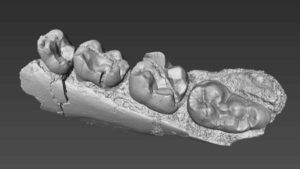
The teeth of a new fossil monkey, unearthed in the badlands of northwest Kenya, help fill a 6-million-year void in Old World monkey evolution, according to a study by U.S. and Kenyan scientists published in the Proceedings of the National Academy of Sciences.
The discovery of 22-million-year-old fossilized monkey teeth — described as belonging to a new species, Alophia metios — fills a void between a previously discovered 19-million-year-old fossil tooth in Uganda and a 25-million-year-old fossil tooth found in Tanzania. The finding also sheds light on how their diet may have changed the course of their evolution.
“For a group as highly successful as the monkeys of Africa and Asia, it would seem that scientists would have already figured out their evolutionary history,” said the study’s corresponding author John Kappelman, an anthropology and geology professor at The University of Texas at Austin. “Although the isolated tooth from Tanzania is important for documenting the earliest occurrence of monkeys, the next 6 million years of the group’s existence are one big blank. This new monkey importantly reveals what happened during the group’s later evolution.”
Since the time interval from 19 to 25 million years ago is represented by a small number of African fossil sites, the team targeted the famous fossil-rich region of West Turkana to try to fill in that blank.
“Today, this region is very arid,” said Benson Kyongo, a collections manager at the National Museums of Kenya. “But millions of years ago, it was a forest and woodland landscape crisscrossed by rivers and streams. These ancient monkeys were living the good life.”
While in the field, the team uncovered hundreds of mammal and reptile jaws, limbs and teeth ranging from 21 million to more than 24 million years old, including remains of early elephants. The newly discovered monkey teeth are more primitive than geologically younger monkey fossils, lacking what researchers referred to as “lophs,” or a pair of molar crests, thus earning the new species its name, Alophia, meaning “without lophs.”
“These teeth are so primitive that when we first showed them to other scientists, they told us, “Oh no, that isn’t a monkey. It’s a pig,” said Ellen Miller, an anthropology professor at Wake Forest University. “But because of other dental features, we are able to convince them that yes, it is in fact a monkey.”
The success of Old World monkeys appears to be closely tied to their unique dentition, researchers said. Today, the configuration of cusps and lophs on the molar teeth enable them to process the wide range of plant and animal foods encountered in the diverse environments of Africa and Asia.
“You can think of the modern-day monkey molar as the uber food processor, able to slice, dice, mince and crush all sorts of foods,” said Mercedes Gutierrez, an anatomy professor at the University of Minnesota.
“How and when this unique dentition evolved is one of the unanswered questions in primate evolution,” said James Rossie, an anthropology professor at Stony Brook University. The researchers speculated that Alophia’s primitive dentition was adapted to a diet that consisted of hard fruits, seeds and nuts, and not leaves, which are more efficiently processed by the more evolved dentition of fossil monkeys dating from after 19 million years ago.
“It is usually assumed that the trait responsible for a group’s success evolved when the group originated, but Alophia shows us this is not the case for Old World monkeys,” said Samuel Muteti, a researcher at the National Museums of Kenya. “Instead, the characteristic dentition of modern monkeys evolved long after the group first appeared.”
The researchers hypothesized that the inclusion of leaves in the diet is what later drove monkey dental evolution.
Monkeys originated at a time when Africa and Arabia were joined as an island continent, with its animals evolving in isolation until docking with Eurasia sometime between 20 million and 24 million years ago. It was only after docking that the mammals today typically considered “African” — antelope, pigs, lions, rhinos, etc. — made their entry onto the continent. So, researchers asked: Could this event and possible competition between the residents and the newly arrived Eurasian species have driven monkeys to exploit leaves, or did changing climates serve to make leaves a more attractive menu entrée?
“The way to test between these hypotheses is to collect more fossils,” Kappelman said. “Establishing when, exactly, the Eurasian fauna entered Afro-Arabia remains one of the most important questions in paleontology, and West Turkana is one of the only places we know of to find that answer.”
The team intends to be back in the field later this year.
Reference:
D. Tab Rasmussen, Anthony R. Friscia, Mercedes Gutierrez, John Kappelman, Ellen R. Miller, Samuel Muteti, Dawn Reynoso, James B. Rossie, Terry L. Spell, Neil J. Tabor, Elizabeth Gierlowski-Kordesch, Bonnie F. Jacobs, Benson Kyongo, Mathew Macharwas, and Francis Muchemi. Primitive Old World monkey from the earliest Miocene of Kenya and the evolution of cercopithecoid bilophodonty. Proceedings of the National Academy of Sciences, March 11, 2019; DOI: 10.1073/pnas.1815423116
Note: The above post is reprinted from materials provided by University of Texas at Austin.










